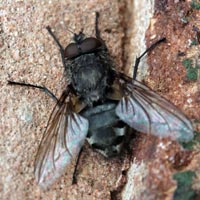Cluster fly biology

Common cluster fly, “Pollenia rudis”
Cluster flies are classed as “flying nuisance insects”. They can enter buildings from August to late November en masse when in gets colder. The main species is the common cluster fly (Pollenia rudis). Cluster flies do not pose a health hazard, because they are strictly parasitic on earth-worms. Cluster flies lay eggs near worm holes and maggots of the cluster fly devour worms internally. They are considered a nuisance, because large numbers can take up residence in attics and quiet rooms to hibernate during winter.
They awake from hibernation when the temperature raises, and can be found in vast numbers on windows and window ledges, as they are attracted to light. The common cluster fly is a little larger than a common house fly (7-10mm). Their movements are more “sluggish” and they are covered in fine bristles. It is thought that specific pheromone signals left by hibernating cluster flies are the cause of yearly reoccurrences in a single targeted location (i.e. in a block of houses only a specific house is continuously affected every year).
The most common cluster fly species are:
- Common cluster fly (Pollenia rudis): Recognizable by a grey, checkered – patterned abdomen and a hairy thorax
- Green cluster fly (Dasyphora cyanella): Looks like a “dull” green bottle fly. Appearance is metallic green or blue.
- Autumn fly (Musca autumnalis): Like a house fly, but with a yellow abdomen
- Yellow swarming fly (Thaumatomyia notata): The size of a fruit fly (3-4mm) with yellow and black markings
Methods to control cluster flies
There is no point in treating cluster flies externally. The first action should be to prevent cluster fly entry by sealing gaps.This can be labour intensive and costly. Cluster flies present in attic and voids can be eradicated by the use of “smoke bombs” containing permetrhrin or by ULV fumigation.
Fire safety should a high priority and permethrin containing pyrotechnics should be lit on a metal level surface with fire extinguishers at hand. Insecticide treatments of attics is likely to be required on a regular basis to keep cluster fly numbers under control. Numbers are likely to be reduced significantly, but complete eradication is not the norm.
An alternative approach is to use suspended electric fly killing units (EFK) for use in attics: These should be installed and maintained regularly by a professional pest control company such as Aardvark Pest Control in light of fire hazards.
